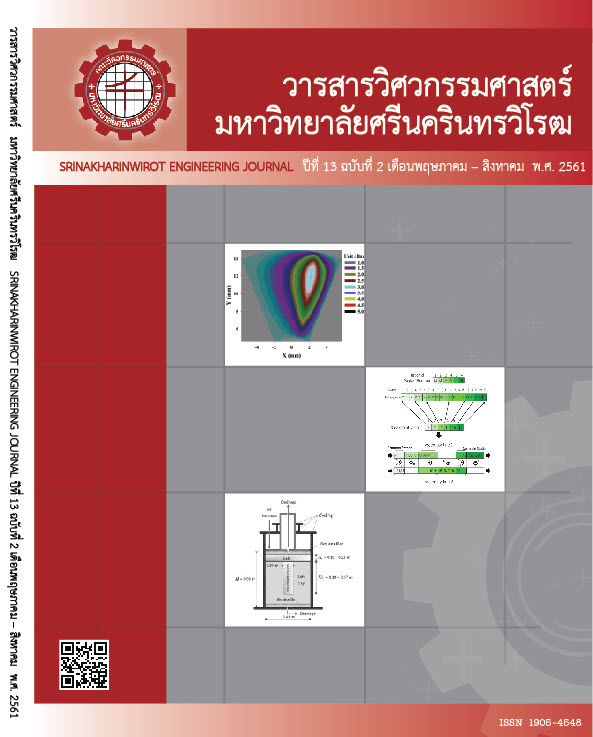Miscoordination Reduction of Directional Overcurrent Relay by Memetic Algorithm
Main Article Content
Abstract
This paper presents coordination of directional overcurrent relays by optimization technic using memetic algorithm, combined with genetic algorithm and shuffled frog leaping algorithm. In addition, this paper proposes a new unconstrained objective equation to reduce miscoordination of main and backup relays, considered near and far-end faults. The proposed method is implemented in two different test cases, three and six bus network. The results show that, in the case of the 3 bus system, the discrimination times are decreased. And in the case of the 6-bus system, the proposed objective equation can reduce miscoordination, at the far-end fault, from 8 points to 2 points. It is found that the effectiveness and superiority of the memetic algorithms compared with the performance of genetic and shuffled frog leaping algorithm.
Article Details
Copyright belongs to Srinakharinwirot University Engineering Journal
References
[2] P. P. Bedekar and S. R. Bhide, “Optimum coordination of directional overcurrent relays using the hybrid GA-NLPApproach,” IEEE Trans. Power Deliv., vol. 26, no. 1, pp. 109-119, 2011.
[3] A. S. Noghabi, J. Sadeh and H. R. Mashhadi, “Considering different network topologies in optimal overcurrent relay coordination using a hybrid GA,” IEEE Trans. Power Deliv., vol. 24, no. 4, pp. 1857 – 1863, 2009.
[4] P. P. Bedekar and S. R. Bhide, “Optimum coordination of overcurrent relay timing using continuous genetic algorithm,” Expert Syst. Appl., vol. 38, no. 9, pp. 11286-11292, 2011.
[5] R. Thangaraj, M. Pant and K. Deep, “Optimal coordination of over-current relays using modified differential evolution algorithms,” Eng. Appl. Artif. Intell., vol. 23, no, 5, pp. 820-829, Aug. 2010.
[6] R. M. Chabanloo, H. A. Abyaneh, S. S. H. Kamangar and F. Razavi, “Optimal combined overcurrent and distance relays coordination incorporating intelligent overcurrent relays characteristic selection,” IEEE Trans. Power Deliv., vol. 26, no 3, pp. 1381-1392011.
[7] C. W. So, K. K. Li, K. T. Lai and K. Y. Fun, “Application of genetic algorithm for overcurrent relay coordination,” in 6th International Conference on Developments in Power Systems Protection., Nottingham, UK, 1997, pp. 66–69.
[8] C.W. So and K.K. Li , “Overcurrent relay coordination by evolutionary programming,” Elect. Power Syst. Res., vol. 53, no. 2, pp. 83-90, 2000.
[9] F. Razavi, H. A. Abyaneh, M. Al-Dabbagh, R. Mohammadia and H. Torkaman, “A new comprehensive genetic algorithm method for optimal overcurrent relays coordination,” Elect. Power Syst. Res., vol. 78, no. 4, pp. 713-720, 2008.
[10] B.Chattopadhyay, M.S.Sachdev and T.S. Sidhu, “An on-line relay coordination algorithm for adaptive protection using linear programming technique,” IEEE Trans. Power Deliv., vol. 11, no. 1, pp. 165 – 173, 1996.
[11] A. S. Noghabi, H. R. Mashhadi and Javad Sadeh, “Optimal coordination of directional overcurrent relays considering different network topologies using interval linear programming,” IEEE Trans. Power Deliv., vol. 25, no. 3, pp. 1348-1354, 2010.
[12] H. H. Zeineldin, E. F. El-Saadany and M. M. A. Salama, “Optimal coordination of overcurrent relays using a modified particle swarm optimization,” Elect. Power Syst. Res., vol. 76, no. 11, pp. 988-995, 2006.
[13] Z. Moravej, M. Jazaeri and M. Gholamzadeh, “Optimal coordination of distance and over-current relays in series compensated systems based on MAPSO,” Energy Convers. Manage., vol. 56, pp. 140–151. Apr. 2012.
[14] M.Ezzeddine and R.Kaczmarek, “A novel method for optimal coordination of directional overcurrent relays considering their available discrete settings and several operation characteristics,” Elect. Power Syst. Res., vol. 81, no. 7, pp. 1475-1481, 2011.
[15] D. Saha, A. Datta and P. Dasm, “Optimal coordination of directional overcurrent relays in power systems using Symbiotic Organism Search Optimisation technique,” IET Gener. Transm. Distrib., vol. 10, no. 11, pp. 2681–2688. 2016.
[16] V. N. Rajput and K. S. Pandya, “Coordination of directional overcurrent relays in the interconnected power systems using effective tuning of harmony search algorithm,”Sustainable Computing: Informatics and Syst., vol. 15, pp. 1-15, Sep. 2017.
[17] S. Chompuming, P. Itthipong, and P. Pongcharoen, “The application of shuffled frog-leaping technic to improve the performance of a memetic algorithm,” (in Thai), in National Operations Research Conference 2007, Bangkok., 2007, pp. 162-174.
[18] Z. Moraveja, F. Adelniaa and F. Abbasi, “Optimal coordination of directional overcurrent relays using NSGA-II,” Elect. Power Syst. Res., vol. 119, pp. 228-236. Feb. 2015.
[19] R. L. Haupt and S. E. Haupt, Practical Genetic Algorithms, NY : Wiley, 2004.
[20] D.Mora-Melia, P. L. Iglesias-Rey, F. J. Martínez-Solano and P.Muñoz-Velasco, “The eficiency of setting parameters in a modified shuffled frog leaping algorithm applied to optimizing water distribution networks,” Water., vol 8, no. 5, pp. 1-14, Apr. 2016.

